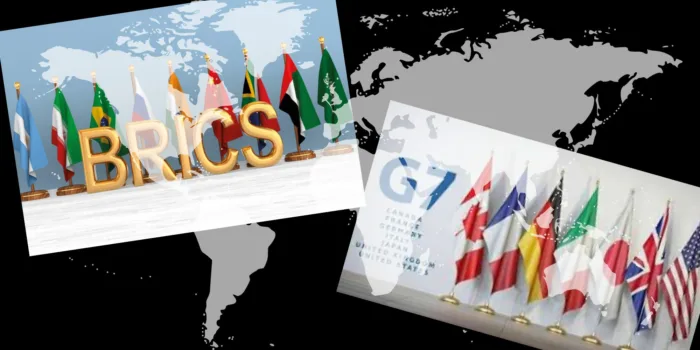Strategic Comparison Between G7 and BRICS: Current Realities and Future Perspectives. The G7 and BRICS represent two of the most influential blocs in the global economy. Although each group faces unique challenges and pursues different objectives, both play a crucial role in shaping global development and stability. This article offers a comprehensive comparison between these blocs, examining economic indicators, social and political realities, and exploring future scenarios that could redefine their global influence.

1. Background and Structure of the Groups
The G7 (United States, Canada, Germany, United Kingdom, France, Italy, and Japan) was formed in the 1970s as a response to global financial crises, aiming to coordinate economic policies among advanced economies. As a bloc of developed economies, the G7 prioritizes financial stability, free trade, and technological innovation.
BRICS, which includes Brazil, Russia, India, China, and South Africa, was formalized in 2006 as a platform for emerging economies, seeking to balance the global economic dominance of the G7. BRICS represents nearly half of the world’s population, and although its members vary in economic and political structure, they share a common goal of increasing economic and political influence on the global stage.
2. Economic Realities and Comparative Indicators
The table below presents key economic indicators for each bloc:
| Indicator | G7 (Average) | BRICS (Average) |
|---|---|---|
| GDP (USD Trillions) | 46 trillion | 27.7 trillion |
| GDP Growth Rate (%) | 1% | 3.6% |
| Total Population | 750 million | 3.24 billion |
| GDP per capita | $45,000 | $6,000 |
| Inflation (2024) | 2% | 4-8% |
Sources: World Bank, IMF, Visual Capitalist, Evaluator Funds (Investingstrategy.co.uk) (Evaluator Funds)
3. Social and Political Analysis
The G7 comprises liberal democracies with advanced market economies. These nations enjoy high standards of living and political stability, though they face challenges such as aging populations and high labor costs, which limit future growth. Furthermore, G7 economies have largely shifted towards services, technology, and innovation, with less reliance on resource-intensive industries.
The BRICS, on the other hand, show substantial diversity in political structure and economic development. For instance, China and Russia have authoritarian regimes, while Brazil, India, and South Africa are emerging democracies. This disparity can pose a challenge for internal cooperation, but BRICS also benefits from a young, growing population and an economy fueled by industrialization and internal consumption.
4. Challenges and Competitive Advantages
G7 Challenges:
- Stagnant Growth: Most G7 countries experience low economic growth rates, with projections around 1% annually (Investingstrategy.co.uk.)
- Global Competition: The growing influence of BRICS and other emerging economies threatens the G7’s dominance in global financial and trade institutions.
- Aging Population: Countries like Japan and Italy face a critical aging population issue, affecting both the labor market and economic growth.
G7 Advantages:
- Innovation and Technology: G7 economies lead in technology and innovation, especially in areas like artificial intelligence and biotechnology.
- Financial Stability: The stability of their currencies and access to global financial markets are strengths for the G7.
BRICS Challenges:
- Economic Inequality: BRICS nations face high levels of inequality and poverty in several member countries.
- Resource Dependence: Economies like Russia and Brazil rely heavily on natural resource exports, making them vulnerable to price fluctuations.
- Political Disparity: Differences in governance systems can create tensions and limit cohesion in decision-making.
BRICS Advantages:
- Population Growth: India and Brazil have young, growing populations, favorable for long-term economic growth.
- Economic Diversification: As some BRICS countries industrialize, the group’s relevance in key sectors like manufacturing and services increases.
5. Strategic Perspectives and Future Projections
Influence on International Trade: BRICS is expected to continue expanding its trade relationships with emerging and developing countries, aiming to create an economic network independent of G7 dominance. China’s “Belt and Road” initiative exemplifies this strategy, consolidating its influence in Asia, Africa, and Latin America. Meanwhile, the G7 strengthens alliances with other advanced nations, seeking to retain its role as the main driver of international trade (Evaluator Funds).
Foreign Investment and Technological Development: The G7 remains the leader in foreign direct investment and technological development but faces competition from BRICS countries like China, which has invested significantly in advanced and renewable technologies. Emerging economies in BRICS may benefit from the growth of the tech sector, driven by internal demand and advances in education and digitalization.
Future Scenarios:
- Integration and Mutual Collaboration: In a positive scenario, the G7 and BRICS could find areas for collaboration, such as climate change and digital trade, benefiting both parties.
- Intensified Competition: In a more competitive scenario, BRICS could solidify as an effective counterweight to the G7, potentially challenging its influence on global trade and finance within two decades (Evaluator Funds).
6. Finally
The G7 and BRICS are both pivotal players in the global economy, each with unique strengths and challenges. While the G7 continues to lead in stability and technology, BRICS presents substantial growth potential and a young population base. As both blocs adapt to a shifting landscape, their influence will depend on how effectively they navigate internal and external challenges and their evolving role in the international financial system. The rivalry, cooperation, or competition between these blocs will largely determine the future trajectory of the global economy.

Team ProdAfrica
team@prodafrica.com